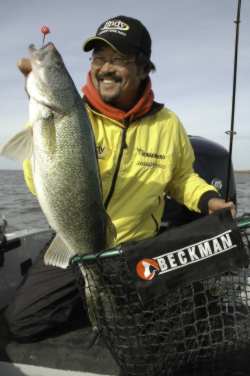There are times when fishing for walleyes
is like putting a candy bar on the coffee table in front
of couch potato trying to go on a diet. He might not eat
it right away, but wait an hour and that chocolate will
be gone.
Faster tactics like trolling or even slower approaches like
rigging will not work all the time. Conditions may dictate
where jigging in one spot or suspending live bait below
a slip bobber is needed just to entice a bite. The longer
a walleye looks, the harder it is for it to resist.
A cold front or just the cold-water periods of early spring
and late fall are two examples when anchoring will work.
There are times when you get on a spot, drift a rig, and
won’t get any bites. But, you anchor, sit still, and
bang, you get hit. The fish are there, but they’re
probably in a negative or neutral mood. The bait just needs
to be in their face a little longer.
There are other times when anchoring will increase your
odds, such as when you’re facing a stiff breeze or
current and boat control becomes an issue. But, despite
an anchor’s effectiveness, it’s likely that
half the anglers reading this article don’t even have
an anchor in their boats. Anchoring is often overlooked
and it’s time to rethink that choice.
Anchoring with Style
Anchors come in two shapes important to walleye anglers.
One is a Water Spike type (lightweight with sharp points),
which digs in clay, mud or sandy bottoms. The other is a
Navy anchor (heavy with 2 large claws), or a variation on
the Navy theme made by Richter (heavy with multiple points).
Navy and Richter are both good on gravel, rocks or boulders.
Have the two different styles (Water Spike and Navy) on
board which work for the different type of bottom conditions
you may face.
Buy big. An 18 to 20 foot boat needs a 26 or even 28 pound
anchor. Smaller boats can get away with lighter weights,
but err on the heavy side. They’re useless if they
don’t keep you in place. Using 2 anchors at the same
time can help.
Have plenty of rope attached. If you don’t use enough,
you will slip out of place and disturb the spot. About 150
feet of rope per anchor should do. Mark it every 10 feet.
If you have to reset them if you slip, you’ll have
an idea of how much to let out next time.
Drop anchors quietly. They can spook fish if you don’t.
You can often get an idea of what type of tactic you are
going to try on a given day before you even get to the water.
The tip comes at the bait shop, and it’s free. Simply
glance in the minnow tanks. Tightly-balled minnows are responding
to the same high pressure, cold front which is impacting
the fish in the lake. Anchoring might be the ticket that
day. If minnows are swimming freely, then search tactics
may come in play.
The effectiveness of anchoring can change over the course
of a single trip to the water, too. Walleyes that are active
in low light may get lockjaw mid-day. Use an anchor as a
tool to switch to slower tactics.
Anchoring is a spot-on-a spot tactic. You must be close
to where walleyes are concentrated for it to work. Watch
for fish on your sonar or stay close to some sort of structure.

Ted Takasaki with a monster walleye caught while
anchored in a prime spot on the Winnipeg River.
The fish fell for a Lindy X-Change jig tipped with
a frozen shiner |
But, you can ring the dinner bell even
if walleyes aren’t directly below you. For example,
there are times when two anglers jigging below the
boat for a while have attracted curious perch to the
area. At first, there might be nothing happening.
Then, 20 minutes later you catch a perch. Then shortly
after that, you boat a good walleye that has followed
the forage fish to the spot.
The lesson learned - if action is slow enough that
you are putting the anchor out, then give a spot some
time. Twenty to thirty minutes is usually enough to
tell if anything is going to happen. Anchors Away!
Anchoring is a great way to approach “edges”
where the depth changes or weedlines or treelines.
Anchor one up on the top and the other down the drop.
Check both depths.
At spots like Devil’s Lake, anchoring can be
done right at the edge of submerged tree lines.
The depth where anchors are effective can vary. You
might want to anchor in a breeze so you can cast small
jigs to wood or weed edges in shallow water near a
point that holds fish. |
Or, you may want to anchor to use slip bobbers to target
a deep rock hump 40 feet down or more. In that case, anchor
parallel to the waves and cast up wide with the weighted
Thill Pro Series bobbers from Lindy. Let the breeze work
the bait over the structure for you. Set the depth so your
jig/bait is a foot off the bottom. The clearer the water,
the higher you can get away with setting the rig.
Anchors also help in rivers where there is current. Anglers
have learned to hold themselves in one place with anchors
at spots like the Rainy River, the Missouri River, as well
as the Winnipeg River.
There was a time when Ted fished a tournament on the Missouri
River in high winds of 30+ mph. He was working rigs on the
tip of a point for hours without a bite (it was so windy
that moving anywhere else was impossible) until his batteries
were exhausted. He knew there were fish around, so he threw
an anchor on the point… it slipped. Threw it again…
it slipped. Threw it one more time… and it held. Once
stationary and allowing some jigs and rigs to sit on the
bottom, they produced a quick limit in 45 minutes and a
3rd place finish. The anchor was anything but unlucky that
day.
Anchors are put to good use in rivers like the Mississippi.
Rather than fighting the river with an electric trolling
motor, use an anchor above the wingdams to cast crankbaits
or live bait on three-way rigs at the base of the dam where
active walleyes will stage to ambush forage which the river
brings to them.
Many anglers probably avoid anchors because of the work
it takes to move to new spots. Well, not so fast. Change
position in wind or current merely by moving the rope from
the front of the boat to a cleat on either side. The motion
of the water or wind swings you over new water to try. Letting
out more rope does the same thing.
But, don’t stay in one area so long that the post
office starts to deliver your mail there. Try other places.
If you’re so sure that the fish are there, fish the
spot, come back later and try again. That walleye “couch
potato” just might be ready to reach for the candy
bar when you return.



